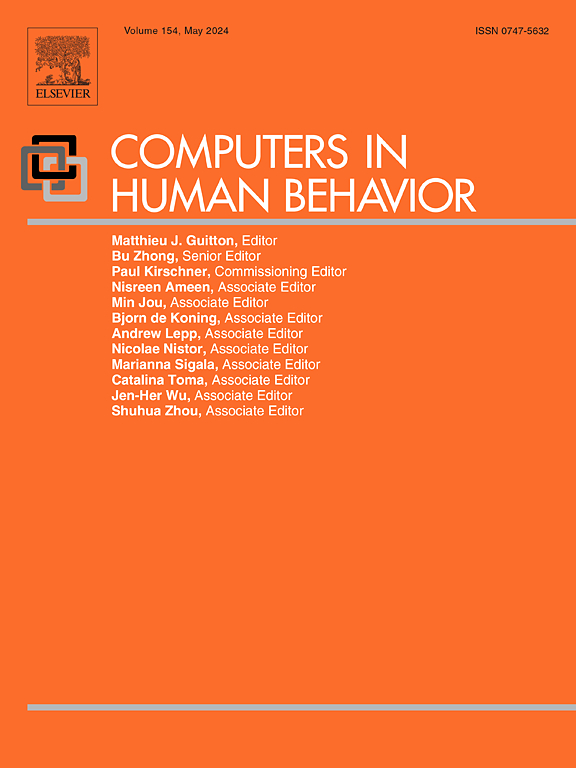Adolescents' engagement in sexting as a normative behavior: Profiles of consensual and coerced sexting
IF 8.9
1区 心理学
Q1 PSYCHOLOGY, EXPERIMENTAL
引用次数: 0
Abstract
Sexting, the exchange of sexual messages or images by digital devices, has become increasingly common in adolescent relationships and is often viewed as a normative expression of teenage sexuality in the digital age. At the same time, sexting carries risks, especially when it is coerced or conducted without consent. The present study, conducted in Israel, used latent profile analysis to identify patterns of sexting behavior in adolescents and to examine differences in background factors in these profiles. Participants were 345 adolescents and young adults (all responses referred specifically to high school experiences) who completed an online survey of sexting behaviors, attitudes, and family communication. Three profiles emerged: non-sexters (83.8 %), sexters (12.2 %), and coerced sexters (4.1 %). Non-sexters reported minimal sexting activity and more open communication with parents, sexters willingly engaged in sexting and embraced permissive sexting norms, and coerced sexters experienced sexting under pressure Girls were overrepresented in the sexter group (78.6 % female) whereas the small coerced sexter group showed no significant gender difference. The profiles did not differ in self-reported religiosity but adolescents in the coerced sexter profile disclosed significantly less information to their parents than those in the two other groups. These findings indicate that although sexting by youths is common and often consensual, a subset experienced it as a form of digital sexual coercion. The results of the study can inform the design of sexting education and shape parenting practices.
青少年参与性短信作为一种规范行为:自愿和强迫性短信的概况
性短信,即通过数字设备交换性信息或图片,在青少年关系中变得越来越普遍,通常被视为数字时代青少年性行为的规范表达。与此同时,发色情短信也有风险,尤其是在被强迫或未经同意的情况下。目前的研究是在以色列进行的,使用潜在特征分析来识别青少年的性短信行为模式,并检查这些特征中背景因素的差异。参与者是345名青少年和年轻人(所有的回答都是指高中经历),他们完成了一项关于性短信行为、态度和家庭沟通的在线调查。出现了三种情况:非性恋者(83.8%)、性恋者(12.2%)和被强迫的性恋者(4.1%)。非sexsexter报告说,sexsexter很少使用性短信,与父母的交流更开放;sexsexter愿意使用性短信,并接受宽容的性短信规范;强迫sexsexter在压力下经历性短信;sexsexter组中女孩的比例过高(78.6%为女性),而少数强迫sexsexter组没有显着的性别差异。这些档案在自我报告的宗教虔诚度方面没有差异,但在强迫性行为档案中的青少年向父母透露的信息明显少于其他两组。这些发现表明,尽管青少年发性短信很常见,而且往往是双方自愿的,但还是有一小部分人将其视为一种数字性胁迫。这项研究的结果可以为性短信教育的设计和塑造父母的做法提供信息。
本文章由计算机程序翻译,如有差异,请以英文原文为准。
求助全文
约1分钟内获得全文
求助全文
来源期刊

Computers in Human Behavior
Multiple-
CiteScore
19.10
自引率
4.00%
发文量
381
审稿时长
40 days
期刊介绍:
Computers in Human Behavior is a scholarly journal that explores the psychological aspects of computer use. It covers original theoretical works, research reports, literature reviews, and software and book reviews. The journal examines both the use of computers in psychology, psychiatry, and related fields, and the psychological impact of computer use on individuals, groups, and society. Articles discuss topics such as professional practice, training, research, human development, learning, cognition, personality, and social interactions. It focuses on human interactions with computers, considering the computer as a medium through which human behaviors are shaped and expressed. Professionals interested in the psychological aspects of computer use will find this journal valuable, even with limited knowledge of computers.
 求助内容:
求助内容: 应助结果提醒方式:
应助结果提醒方式:


